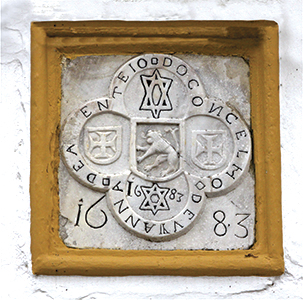 |
This is the municipality’s oldest coat of arms that is known, probably from the 15th century or even earlier. Made in marble, it is formed by four semicircles in low relief, arranged in the form of a cross, sculptured on a square stone. It displays the heraldic elements of the Riba de Vizela family: a lion, in position designated by "andante", flanked by two pattée crosses.
The presence of these nobility symbols is justified because D. Gil Martins de Riba de Vizela (1235-1274) - noble knight, master butler of the portuguese King D. Afonso III - was the first lord of the land corresponding to the present village of Viana. This territory was then designated as Estate de Foxem, and was donated to D. Gil Martins de Riba de Vizela in 1259 by the municipality of Évora, by royal order of the portuguese King D. Afonso III, in order to repay him for the good services rendered to the Crown. The next village landlord was his son Martim Gil (1255-1295) and, later, his grandson, also named Martim Gil (count of Barcelos). The jurisdiction of this family over the town, founded by D. Gil Martins, is the reason why their heraldic symbols appear in the municipal coat of arms.
The coat of arms also has two stars of David, or seals of Solomon, alluding to the Jewish community that existed in the village since its foundation in the 13th century until, at least, the 15th century.
The village, which might have been generated here by D. Gil Martins, with the purpose of occupying the territory, promoting its defence and economic development, was named Viana de Foxem. Following the investigation of Francisco Baião, we know that this same name was engraved on this coat of arms until the inscription was changed, probably already in the 18th century, in an attempt to correspond the representation with the most actual designation of the village. In fact, over time the locality’s designation has changed: Viana de Foxem (or Foxin, or Fosin...), Viana a par de Alvito (Viana alongside Alvito or Viana de Alvito), Viana a par de Évora (Viana alongside with Évora) and Viana do Alentejo. However, the different names at certain times were used indiscriminately. For instance, already in the 17th century, the term that is written in the opening of a council stances book was still Viana de Fossin, in a time when the village was already named Viana alongside Alvito, a designation that appears in the 15th and 16th centuries.
This coat of arms, given its characteristics, may have come from the old Town Council, located in the castle until the end of the 17th century, when the new building was constructed in the Square to where the coat of arms was transferred, and where is found today. At that time it was ordered the engraving of the date 1683 on the base stone of the coat of arms, to signal the beginning of the new council’s construction works.
REFERENCES
BAIÃO, Francisco, “A «vila que chamam Foxem e o seu termo»”, Boletim Municipal do Município de Viana do Alentejo, nº79, Junho de 2013, pp. 38-39.
BAIÃO, Francisco, “A Herança dos Riba de Vizela: As Armas da Vila de Vianna de Foxen”, Boletim Municipal do Município de Viana do Alentejo, nº 81, Fevereiro de 2014, pp. 32-33.
TÁVORA, Luís Gonzaga de Lancastre e, O estudo da sigilografia medieval portuguesa, Lisboa, Instituto de Cultura e Língua Portuguesa, 1983.

 Abrir Lista
Abrir Lista MUNICÍPIO DE VIANA DO ALENTEJO
MUNICÍPIO DE VIANA DO ALENTEJO